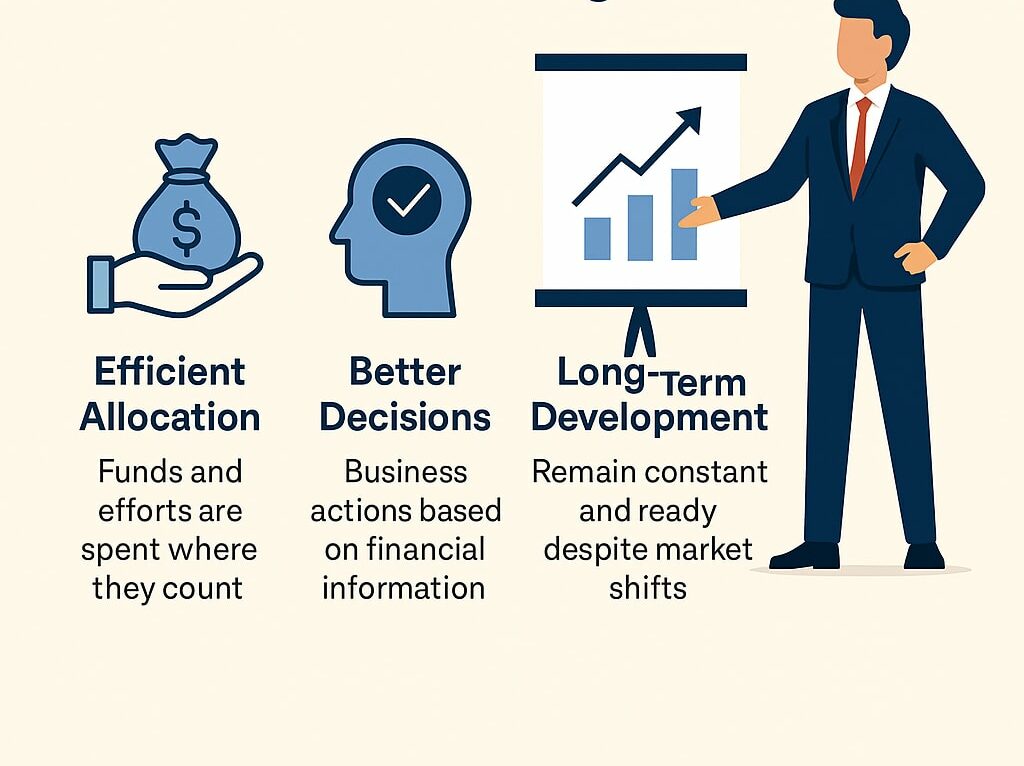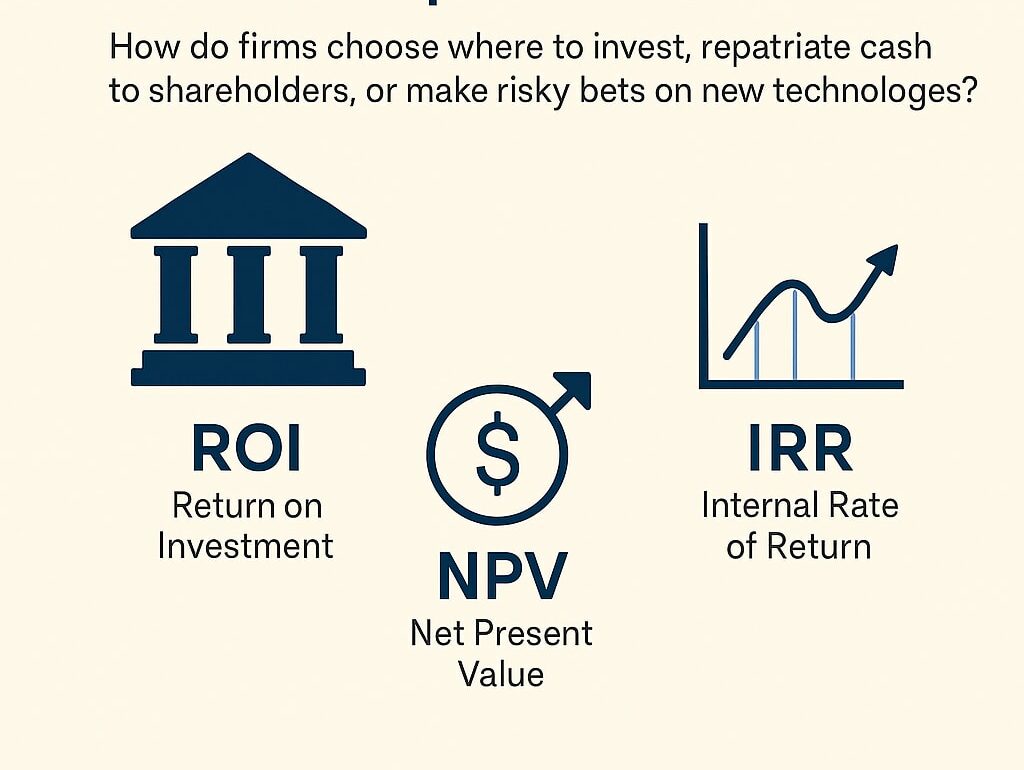What Is Strategic Financial Management and Why Is It Crucial for Business Success?
Table of Contents

Did you know that more than 60% of businesses fail within the first five years, primarily because of poor financial planning and decision-making? In today’s competitive and fast-paced market, a solid financial plan is not an option—it’s a requirement. That’s where Strategic Financial Management comes into play.
So, what is strategic financial management? It’s a process of taking a company’s financial resources and aligning them with the company’s long-term goals and mission, with a focus on sustainability, profit, return on investment, and growth. It’s more than just managing budgets; it is about strategic financial Management planning, investment decisions, risk management, and tracking performance to help make better business decisions.
What is Strategic Financial Management?
Strategic financial management is a concept that refers to the ability to manage a business enterprise’s funds so that the company’s objectives are achieved. It represents a method of management that incorporates various methods and financial instruments to develop a strategy. Strategic financial management makes sure that the correct strategy is achieved to materialize the aims and objectives.
The Importance of Financial Management in Strategic Decision-Making

Wise strategic financial management contributes to smarter business decisions, the wise utilization of resources available, and long-term stability. Finance, when applied in crafting the strategy of a company, not only controls the budgets and expenses but also contributes significantly to ensuring that the company develops and remains competitive.
Finance integrated into the planning process enables companies to become proactive instead of reactive, thus planning. Finance leaders will be able to identify the risks involved, discover new opportunities, and facilitate major decisions that will determine the future of the company.
This is how the Importance of Financial Management in Strategic Decision-Making is:
- More efficient allocation of funds and efforts: Ensuring that money and efforts are spent where they count.
- Better decisions: business actions based on the use of financial information.
- Long-term development: Remain constant and ready, even in the case of transformation of the market.
As a bona fide strategist, finance can provide organizations with much-needed direction and confidence to grow, change, and succeed.
How Strategic Financial Planning Shapes Business Growth
Market-leading finance teams aspire to accomplish strategic finance—in which financial planning excels beyond day-to-day operations to influence the success of the business in the long term. They have to achieve this by making a solid foundation that is supported by correct data management, detailed reporting and analysis, active financial forecasting and financial modeling, and constant monitoring of performance.
Such a base means that finance teams will be able to be in charge of data integrity, provide relevant insights, and make informed, forward-looking choices, which will drive financial strategy towards the overall business objectives.
- Data management
According to a study by McKinsey data, it is proved that data-based companies are 19 times more profitable. However, it will be impossible to make informed, high-impact decisions without precise, complete, and trustworthy data. All of the financial judgments that you make, including budgeting, forecasting, are dependent on the quality of your data.
Data integrity makes business data accurate and complete. Having a high level of data integrity, businesses may prevent mistakes, fraud, and uninformed decision-making, which can be rather expensive. You can preserve data integrity by conserving good records, undertaking periodic auditing of records, and applying advanced software to handle financial information.
The essential data management activities that you can incorporate into a process that encourages data integrity include:
- Data governance: Clarify which financial data is important to the business and put in place uniformity in the collection process, and how it is stored and managed. Accountability facilitates uniformity and enhances decision-making.
- Data cleansing: Scrub and refresh financial information regularly to eliminate stale information, rectify the differences, and get rid of duplicates. This eliminates the possibility of erroneous communication of forecasts and financial reports.
- Data consolidation: Organize financial data in a more effective manner such that core business drivers are centered, hence taking less time to monitor performance trends and produce accurate reports. Cross-system integration provides a source of truth.
- Reporting, Analysis
When reporting and analysis are successful, your quality data will turn into trends and ideas that you will use to create a strategic plan. It aids in displaying your financial data in a resume form that is simple to comprehend, which then makes it possible to respond to vital questions as follows:
- Just how much is the business doing?
- What do the businesses cost?
- What areas can the organization target to reduce expenditures and increase revenue?
This answers the question of why businesses perform the way they do and how the organization can repeat the successful strategic initiatives to scale up in the future.
- Modeling and planning
Planning, budgeting, and modeling involve determining the most appropriate methods of using and allocating the company’s finances to attain the strategies. Effective financial planning will assist you in not only predicting potential problematic situations but also in the flexibility of the course and in fulfilling business goals. Budgeting has limits in terms of spending depending on the imminent revenue; thus, the allocation is efficient. An example could be based on the fact that a company is intending to introduce a new product, the budget must support the research to be conducted, the actual production, and the marketing aspect, as well as the distribution, where the profitability is upheld.
Financial modeling is the estimation of alternative courses of action and outcomes to make decisions about the strategized plans. To illustrate, when you intend to open a new market, a financial model will present the situation on how this move is going to influence your cash flow and whether you will obtain the best ROI.
A strong financial planning, budgeting, and modeling process may incorporate:
- Cash flow forecasting: Establishing that the business has sufficient funds that can be used to settle its expenses.
- Operational budgeting: Developing budgets to cater to the short-term objectives of the business.
- Breakeven analysis: Assessing the feasibility of a new project, which determines whether the project will be profitable.
These processes can be made efficient with the special finance software. Discover budget and forecasting software that can analyse information in real-time and have shorter turnaround times.
- Performance monitoring
Strategic financial management is a process by which you will be pushed to constantly evaluate financial plans and strategies and change them in case of necessity. In the planning, they normally establish key performance indicators (KPIs) to monitor progress toward each business aim, such as revenue growth or gross margin, or operating cash flow, among others.
Focused monitoring will enable you to figure out holes that need to be filled and make informed decisions in the shortest time possible. Making sure that your financial reporting and decision-making are in line with these essential business drivers at all times will enable your team to direct its energies where it matters most.
Strategic Corporate Finance: Driving Value Through Smart Capital Decisions
This segment of Corporate Finance Explained explores capital allocation, the strategic process behind a company’s most significant financial decisions. We examine how firms decide where to invest, whether to return cash to shareholders, or to take calculated risks on emerging technologies.

A group of essential metrics is used by companies. They are not merely concepts, such as abstract numbers. They are the instruments that assist in evaluating the profitability of various investments. As an illustration of the profitability of an investment gauge to its cost, there is an index called the ROI, or the return on investment. It assists companies in comparing their various projects and choosing the most potentially profitable ones. Thus, ROI is a sort of instant picture of how well a company is spending its money. Exactly. What other metrics do they use? The other important indicator is net present value or NPV. It considers the time value of money, that in the present, a dollar is worth more than a dollar in the future. Thus, NPV is a calculation of the present value of cash flows that an investment earns in future terms and brings them back to the current dollars. The NPV, therefore, assists in confirming whether or not a given investment is producing any value to the business, considering the time lag before such returns are realized. Right. These measures seem to sound much like data-informed decision-making. Precisely. And then there is the internal rate of return, or IRR, the discount rate at which the NPV of an investment is zero. This represents the expected annual rate of return for a project. OK. Beginning to see how all of these metrics sort of fit together. Thus, they apply these tools to compare various alternatives, such as investing in new product development rather than the acquisition of another company. Exactly. And even in these broader resolutions, still more exact ones have to be taken into consideration.
Finance and Strategic Management: A Powerful Business Duo
SBP Power of Strategic Business Partnership
The most effective way of solving challenges is by using the well-known quote that two brains are better than one. Value-added business partnering is the future role that the financial planning and analysis (FP&A) function plays in supporting the business with its demands.
According to the research of 2018, conducted by Gartner, the appropriate FP&A business collaboration can lead to a process of decision-making that might bring X of the profits. This explains why it is very essential and why it is important to remain ahead of the competition by ensuring that FP&A becomes a strategic business partner. The strategic finance business alliance would mostly revolve around ensuring that the entire corporation is empowered and that the finance unit would become a profit center.
5 Steps on the Journey to FP&A Business Partnering
Step 1: Develop Excellent Basic Principles of Finance
Once you begin with clean, about-right data and trustworthy financial reports, then you have an organized picture. This provides a good foundation to make an intelligent business decision.
Step 2: Learn the Business Line
Do something other than financial–Study the functions of every segment of the business. Listen and define the objectives, issues, and opportunities for how your finance expertise can be of assistance.
Step 3: Build Relationships of Trust
Interact with various groups. Become a good listener and a communicator to ensure that people do not regard the finance team as a source of numbers rather than a valuable partner.
Step 4: Have a Clear, Actionable Insight
It is important not to show data, but rather a story. Bring wisdom in terms of giving guidance to teams to make better decisions fast and with confidence.
Step 5: Drive Strategy, Influence Change
Get your financial knowledge to form plans. Become a leader involved in making long-range decisions and business transformations.
Real-World Examples of Strategic Financial Management in Action
Have you ever wondered how major corporations can afford such radical decisions and remain unaffected by them financially? It is strategic financial management. Whenever there is a brilliant merger, significant growth, or market penetration, there is a financial strategy behind it.
So, without talking any more in circles, it is probably time to take a look at some real-life examples of real money and how using funds can be approached strategically and turn into a serious game-changer.
1. Apple Share Buyback Program, worth 100 Billion
Apple is an innovative company; there is no doubt about it. However, its financial policies are remarkable too. Furthermore, Apple introduced a humongous $100 billion share repurchasing program in 2018, which elevated shareholder value and proved the faith in the long-term stability of the company.
What it demonstrates: Related to strategic financial Management planning, Apple took precedence in optimizing its capital structure, creating value for shareholders, and having a high balance sheet, with no implication on its innovation budget.
2. The reinvestment strategy of Amazon
Amazon had been spending billions of dollars reinventing itself through an expansion of warehouses, the AWS (Amazon Web Services), new markets, etc., instead of concentrating on profits.
What it indicates: A strategic financial Management action either postpones short-term profits for enormous long-term profits. Scalability was the primary concern of the finance team of Amazon, and currently, AWS is bringing in billions of dollars in revenue.
3. Fleet Modernization of Delta Airlines
Due to the high cost of fuel, Delta spent a lot of money on replacing older aircraft with fuel-efficient ones, lowering its long-term expenses on operations.
What it demonstrates: Using strategic capital allocation, Delta was able to overcome the potential impact of fuel prices on their business and costs and optimize the customer experience, and this was achieved through clever financial forecasting and planning.
Tips to Implement Strategic Financial Management in Your Organization
Tips on How to Use Strategic Financial Management within Your Company
Strategic Financial Management (SFM) not only applies to large corporations but to any business of any size. At its best, SFM can assist your company in growing with intent, working responsibly within a risk management realm, and making long-term decisions with confidence.
The following are some basic tips to make your start easier:
- Link Finance to Business Objective
Ensure your financial management complements the mission and vision of your company. Finance is not supposed to be silo finance; every monetary move must contribute to the strategic growth, such as expanding the market, developing products, or retaining customers.
- Take Data-Supported Actions
Use actual up to date financial reports and analytics, not intuition. Software such as dashboards and forecasting software allows you to monitor the KPIs and therefore forecast the trend and consequently make informed decisions that would minimize financial risk.
- Promote Cross-Departmental Working
Finance needs to be an ally, not a gatekeeper or controller. Always collaborate with sales, marketing, HR, and operations to know their needs and advise them on financial directions to suit their needs.
- Insertion of technology and automation
Contemporary finance resources, such as ERPs, financial modeling, and cloud accounting, are time-saving and more accurate. Automation also liberates your finance department to concentrate on endorsing as opposed to manual work.
- Attention to the Long-Term Planning
Do not only solve temporary problems. Establish long-range financial forecasts that help to position your business in advance of growth, changes in the economy, and potential opportunities.
- Establish a Culture about Finances
Educate the leaders and managers in different departments on major financial concepts. As soon as all the people within your company understand the flow of money, smart decisions will be made at all levels.
- Constantly Review and Better
Financial management as a strategic project is not a one-off. Put periodic reviews in place to monitor performance, realign strategies, and remain flexible in churning markets.
From Confusion to Clarity: Jaro Education’s Role in Career Planning
Making the right choice of career is a hard task; however, with the help of Jaro Education, which is headed by career counseling experts and its career counseling program, confusion will be converted into clarity due to its one-on-one counseling guidance. Having had a success rate of more than 85 percent in helping their students secure roles in line with their degree training in the industry, Jaro combines a one-on-one mentorship program, psychometric testing, and personal learning recommendations. The most notable of them is mapping of the career, skill-gap analysis, resume preparation, mock interviews, and consistent guidance by academic and industry mentors. You may be a student with confusion about your next step or a working professional who wants to change his or her career path; Jaro Education offers the guidance and path to establish a successful and future-oriented career.
Conclusion: Why Strategic Financial Management is Non-Negotiable in Today’s Market
Strategic Financial Management has become something mandatory in a world where every financial adjustment can be a deciding factor in breaking or making a business.
Financial management is crucial regardless of whether you are a startup or a multinational company because it provides the potential to steer upcoming decisions, offers skilled resource distribution and promotes long-term viability. What then is strategic financial management? It is more than budgeting; the budget process involves the convergence of financial aspirations through shrewd test planning, forecasting, and analysis with business strategies.
Frequently Asked Questions
What is Strategic Financial Management and why is it important for modern businesses?
Strategic Financial Management refers to the long-term planning and management of a company’s financial resources to achieve its business goals. It involves aligning finance with business strategy to ensure sustainability, growth, and profitability. The importance of financial management here lies in making informed decisions, optimizing investments, and preparing for market changes.
How does Strategic Financial Planning support business growth and stability?
Strategic financial planning involves setting financial goals, forecasting future needs, budgeting, and managing risks. It helps businesses allocate resources wisely, avoid cash flow problems, and make strategic investments—all of which are crucial for stable and scalable growth.
What are the key elements of Strategic Financial Management?
The core elements include long-term financial planning, capital budgeting, risk management, cost control, performance monitoring, and aligning financial activities with overall business objectives. These components ensure that financial decisions support strategic goals.
How does Strategic Corporate Finance differ from traditional finance?
Strategic Corporate Finance focuses on long-term value creation through capital structure decisions, mergers and acquisitions, dividend policies, and investment strategies. Unlike traditional finance, which emphasizes short-term results, strategic corporate finance looks at maximizing shareholder value over time.
What role does finance play in strategic management processes?
In finance and strategic management, finance acts as a critical partner by providing data-driven insights, forecasting outcomes, and guiding resource allocation. Finance teams help leadership evaluate options, assess risks, and ensure strategies are financially feasible and sustainable.
Recent Blogs
It seems we can't find what you're looking for.















